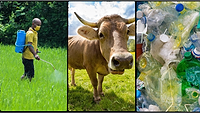Food Safety Implications of Big Data, Microbiome, Foodborne Pathogens, Food System Resilience

Credit: Arno Senoner (arnosenoner) via Unsplash
The Global Food Safety Initiative (GFSI) has released its first Science and Technology Advisory Group (STAG) Report, which provides an “objective and independent” review of current science and technology trends that may impact GFSI’s food safety activities and help define a sustainable future for food safety. The STAG Report focuses on four themes: “Big Data” in food safety, the role of the microbiome in food safety, emerging foodborne pathogens, and food system resilience—impacts on food safety.
A lead author has written each section of the STAG Report with input and assessment from the other STAG members. Prior to publishing, each section was formally reviewed by a different independent group. Overall, the STAG Report provides an overview or introduction into crucial areas of science and technology as they relate to food safety, allowing the food professional to understand why these areas are important, their scope, and likely impact.
Big Data in Food Safety
The term “Big Data” in the STAG Report refers to large volumes of different types of data, the food safety applications of which are numerous. Big Data can be, and often is, collected along all steps of the food supply chain. Specific examples of Big Data relevant to food safety highlighted by the STAG Report are whole genome sequencing (WGS), metagenomics, metabarcoding, sensors, online food safety databases and data sources, predictive analytics, social media and e-commerce data on the internet, and data being collected from farm to fork.
Big Data can be leveraged with blockchain, dynamic risk management systems, and supply chain decisions to respectively improve traceability, identify and respond to food safety hazards, and reduce spoilage. Additionally, next-generation sequencing such as WGS, metagenomics and metabarcoding, and cataloging the microbiome of food products can enhance knowledge of important information on foodborne pathogens, improve regulatory enforcement activities, better detect and surveil foodborne pathogens and outbreaks, and inform spoilage prevention.
Sensor technology is another promising tool that can be used to collect and access real-time information about a product at any point along the supply chain and inform decisions. Finally, social media and handheld smart devices can be useful in predicting the occurrence of foodborne illness outbreaks and improve food safety at the retail level.
The STAG Report recognized key knowledge gaps that exist about Big Data and food safety, including data ownership and privacy, interoperability, identifying and linking relevant data, the need for standardization of Big Data and genomic methods, barriers to adoption for low- and middle-income countries (LMICs), challenges of using artificial intelligence (AI) without human intervention, and limitations of metagenomics. However, the potential impacts of Big Data on food safety are considerable, as being better informed about factors affecting food safety can inform decisions and lead to better incident response. The STAG Report encourages food businesses to look to the future and consider how Big Data can be leveraged within their operations.
The Role of the Microbiome in Food Safety
The STAG Report defines the “microbiome” as it relates to food safety as the ecological community of commensal microorganisms that exist within any environmental sample, as well as the microbial structures; metabolites; mobile genetic elements such as transposons, phages, and viruses; and relic DNA embedded in the environmental conditions of the habitat. Culture independent approaches to pathogen detection, facilitated by advances in high throughput sequencing (HTS) technologies, have greatly enhanced the general understanding of microbiome composition and function in different environments and products, and more recently, how it may be advantageously manipulated or utilized.
Specifically, the baseline monitoring of the microbiome of raw ingredients can reveal changes that may be an indicator of an ingredient’s quality or safety. Many varied factors can influence a product’s microbiome throughout the production and retail chain, such as its packaging type, processing environment, food matrix composition, and others. Additionally, understanding the microbial communities present in food processing environments can pave the way forward for cleaning and sanitization practices. Microbiome analysis can also demonstrate food authenticity, reveal the impact of the presence of a foodborne pathogen on a product, facilitate the identification of antimicrobial resistance (AMR) gene determinants, and improve understanding of how mycotoxins affect human and animal gut microbiomes.
There are several knowledge gaps related to food microbiome analysis that must be overcome in the context of food safety, such as finding ways to modulate microbial community interactions, which influence pathogen survival; variation in results from the use of different methods and tools; cell viability in pathogen detection; the need for standard operating procedures (SOPs) for industry testing and analysis; and the complexity of utilization and outputs from many metagenomics analysis tools. Still, the potential for microbiome applications in food production is vast, and the STAG Report recommends that businesses implement a robust sampling plan, with sufficient sampling to build up a baseline for benchmarking.
Emerging Foodborne Pathogens
The STAG report underlined several emerging foodborne pathogens of concern, as well as tangential considerations. Examples of specific emerging foodborne pathogens mentioned by the report are Escherichia coli O104:H4, Salmonella enterica serovar Infantis, Campylobacter jejuni, Cronobacter, Cyclospora, and norovirus. The issue of emerging foodborne pathogens is further complicated by factors such as AMR; multi-drug resistance (MDR); reoccurring, emerging, and persisting (REP) strains; and highly virulent hybrid strains.
The incidence and prevalence of human infectious diseases are constantly affected by multiple biological, human, and environmental factors, including human demographics, consumers, food type, specific pathogens, agriculture and the environment, education, public health, and social aspects. The report notes that one of the most important factors affecting the food supply chain is globalization, which is considered to be a facet of human demographics.
There exist significant knowledge gaps on AMR, MDR REP pathogens, highly virulent hybrid strains, parasitic pathogens, and the ability to anticipate the next emerging pathogens, which are crucial to explore to prevent foodborne illness outbreaks and the ramifications of such public health incidences. The STAG Report recommends that food businesses and the industry at large reduce antimicrobial use for livestock; invest in research to provide solutions concerning surveillance, detection, ecology and control, and development of private and public surveillance systems; utilize WGS; and employ a combination of traditional approaches and new technologies such as artificial intelligence, machine learning, and predictive microbiology to reduce the presence of pathogens.
Food System Resilience: Impacts on Food Safety
The STAG Report uses the Food and Agriculture Organization of the United Nations’ (FAO’s) definition of food system resilience, which is: “The ability to prevent disasters and crises as well as to anticipate, absorb, accommodate, or recover from them in a timely, efficient, and sustainable manner.” Food system resilience is crucial to food safety as disruptions in the quality or quantity of food provided to populations can have long term impacts on health, productivity, and economic growth.
Shocks to food systems can directly impact the overall safety of food. The report outlines three ways in which lack of system resilience can lead to food safety issues:
- Shocks can create shortages of food safety-related supplies or equipment
- Shocks can create bottlenecks that severely reduce production, and the incentives that exist to clear such bottlenecks may lead to the temporary abandonment of best practices and a corresponding increase in food safety risk
- Malnutrition that results from system failures increases susceptibility to disease, leading to an increase in number and severity of illnesses.
Additionally, the relationship between food security and illness can lead to cycles that undermine long-term health prospects for a community or nation, especially in LMICs.
Although system resilience is outside of the control of a single firm, the report notes that it is important to understand how the system will react to a crisis to understand the risks to individual firms. Several factors affecting food system vulnerability and resilience were identified in the report, specifically: reliance on sole sourcing or a small number of suppliers, reliance on specific ingredients, existing within longer or shorter supply chains, genetic diversity in produce and livestock, infrastructure quality, various trade factors, flexibility of government rules, regulatory incentives, and being a LMIC.
The STAG Report stresses the need to fill knowledge gaps on how the economics of food system resilience affect food safety, determining optimal resilience, and firm and worker behaviors during a crisis. Resilient food systems will bring benefits to food businesses, governments, and communities. The report encourages businesses to improve food safety through enhanced resilience by examining the sources, actions, incentives, and consequences of food safety failures due to low resilience.Looking for a reprint of this article?
From high-res PDFs to custom plaques, order your copy today!






